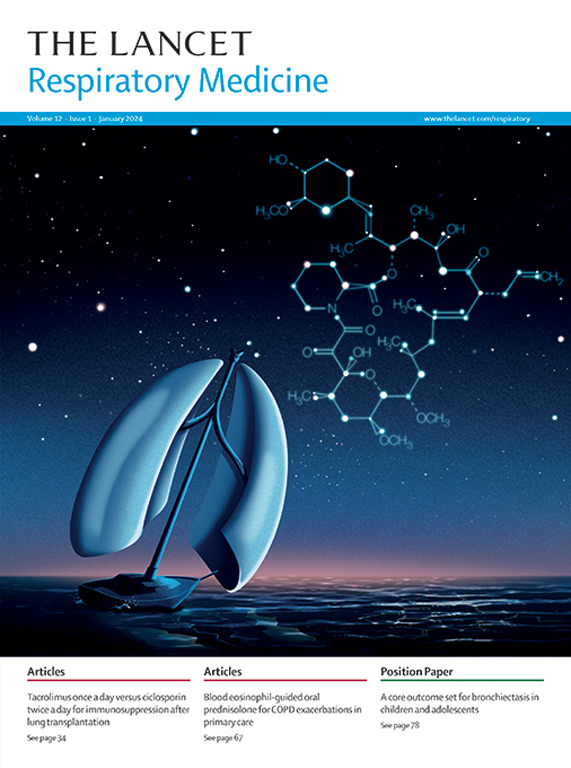Associations between life-course FEV1/FVC trajectories and respiratory symptoms up to middle age: analysis of data from two prospective cohort studies
IF 38.7
1区 医学
Q1 CRITICAL CARE MEDICINE
引用次数: 0
Abstract
Background
Life-course lung function trajectories leading to airflow obstruction, as measured by impaired FEV1/FVC (forced vital capacity), precede the onset of chronic obstructive pulmonary disease (COPD). We aimed to investigate whether individuals on impaired FEV1/FVC trajectories have an increased burden of respiratory symptoms, including those who do not meet the spirometric criteria for COPD.Methods
We analysed serial life-course data from two population-based cohort studies separately, which included respiratory symptoms and spirometry: the Tasmanian Longitudinal Health Study (TAHS, Australia) cohort was recruited at age 6–7 years and followed up until middle age (mean age 53 years; range 51–55); and the Coronary Artery Risk Development in Young Adults (CARDIA, USA) cohort was recruited at a mean age of 25 years (range 18–30) and followed up to a mean age of 55 years (range 47–64). Participants' symptom profiles at ages 53 and 55 years were derived by latent class analysis. Symptom profiles were compared across pre-bronchodilator FEV1/FVC trajectories derived by group-based modelling, then restricted to those without COPD defined by post-bronchodilator airflow obstruction (FEV1/FVC <5th percentile) at ages 51–55 years and 47–64 years.Findings
Six FEV1/FVC trajectories previously derived for TAHS were replicated in CARDIA. Optimal models identified five symptom profiles in TAHS (n=2421) and six in CARDIA (n=3153). For both cohorts, the most impaired FEV1/FVC trajectory (early low, rapid decline in TAHS; low peak, rapid decline in CARDIA) was associated with predominant wheeze (multinomial odds ratio [mOR] 6·71 [95% CI 4·10–10·90] in TAHS and 9·90 [4·52–21·70] in CARDIA) and nearly all respiratory symptoms (4·95 [2·52–9·74] and 14·80 [5·97–36·60]) at age 51–55 years in TAHS and age 47–64 years in CARDIA, compared with the average trajectory. Among individuals belonging to the three most impaired trajectories, the associations with predominant wheeze increased with worsening FEV1/FVC impairment and persisted when considering only those without spirometry-defined COPD. Additionally, for those belonging to the two rapid decline trajectories, both wheezing and usual phlegm or bronchitis were reported by 54 (20%) of 265 participants younger than 14 years in TAHS and by 31 (25%) of 123 participants aged 30 years or younger in CARDIA.Interpretation
In two independent cohorts that collected similar data, people on impaired FEV1/FVC trajectories often had a longstanding history of both wheeze and phlegm or bronchitis, and wheeze was the predominant symptom in individuals aged 47–64 years among those who had not already progressed to COPD.Funding
National Health and Medical Research Council (Australia); The University of Melbourne; Clifford Craig Medical Research Trust; Victorian, Queensland & Tasmanian Asthma Foundations; Royal Hobart Hospital Research Foundation; Helen MacPherson Smith Trust; GlaxoSmithKline; National Heart, Lung, and Blood Institute of the US National Institutes of Health.生命过程FEV1/FVC轨迹与中年前呼吸道症状之间的关系:来自两项前瞻性队列研究的数据分析
在慢性阻塞性肺疾病(COPD)发病之前,通过FEV1/FVC(强迫肺活量)受损来测量导致气流阻塞的生命过程肺功能轨迹。我们的目的是调查FEV1/FVC轨迹受损的个体是否有增加的呼吸症状负担,包括那些不符合COPD肺量测定标准的个体。方法:我们分别分析了两项基于人群的队列研究的连续生命过程数据,包括呼吸症状和肺活量测定:塔斯马尼亚纵向健康研究(TAHS,澳大利亚)队列在6-7岁时招募,随访至中年(平均53岁;51-55范围);青年人冠状动脉风险发展(CARDIA, USA)队列的平均年龄为25岁(18-30岁),随访至平均年龄55岁(47-64岁)。参与者在53岁和55岁时的症状概况通过潜在类别分析得出。通过分组建模,比较了使用支气管扩张剂前FEV1/FVC的症状特征,然后将其限制在51-55岁和47-64岁的无COPD患者中,以支气管扩张剂后气流阻塞(FEV1/FVC <;第5百分位)定义。研究发现,先前为TAHS导出的6个FEV1/FVC轨迹在CARDIA中得到了复制。最佳模型确定了TAHS患者的5种症状特征(n=2421)和CARDIA患者的6种症状特征(n=3153)。在这两个队列中,FEV1/FVC受损最严重的轨迹(TAHS早期低,快速下降;与平均轨迹相比,低峰值,快速下降的CARDIA)与51-55岁的TAHS和47-64岁的CARDIA患者的主要喘息(多项优势比[more] 6.71 [95% CI 4.10 - 10.90], CARDIA患者的多项优势比[more]为9.90[4.52 - 21.70])和几乎所有呼吸道症状(4.95[2.52 - 9.74]和14.80[5.97 - 36.60])相关。在属于三个最受损轨迹的个体中,随着FEV1/FVC损伤的恶化,与主要喘息的关联增加,并且仅考虑那些没有肺活量测定定义的COPD时,这种关联持续存在。此外,对于那些属于两种快速下降轨迹的患者,TAHS中265名年龄小于14岁的参与者中有54名(20%)报告了喘息和痰或支气管炎,而CARDIA中123名年龄小于30岁的参与者中有31名(25%)报告了喘息和痰或支气管炎。在两个收集类似数据的独立队列中,FEV1/FVC轨迹受损的患者通常有长期的喘息和痰或支气管炎病史,并且喘息是47-64岁尚未进展为COPD的个体的主要症状。资助国家卫生和医学研究委员会(澳大利亚);墨尔本大学;克利福德·克雷格医学研究信托基金;维多利亚,昆士兰&;塔斯马尼亚哮喘基金会;皇家霍巴特医院研究基金会;海伦·麦克弗森·史密斯信托;葛兰素史克公司;美国国立卫生研究院的国家心脏、肺和血液研究所。
本文章由计算机程序翻译,如有差异,请以英文原文为准。
求助全文
约1分钟内获得全文
求助全文
来源期刊

Lancet Respiratory Medicine
RESPIRATORY SYSTEM-RESPIRATORY SYSTEM
CiteScore
87.10
自引率
0.70%
发文量
572
期刊介绍:
The Lancet Respiratory Medicine is a renowned journal specializing in respiratory medicine and critical care. Our publication features original research that aims to advocate for change or shed light on clinical practices in the field. Additionally, we provide informative reviews on various topics related to respiratory medicine and critical care, ensuring a comprehensive coverage of the subject.
The journal covers a wide range of topics including but not limited to asthma, acute respiratory distress syndrome (ARDS), chronic obstructive pulmonary disease (COPD), tobacco control, intensive care medicine, lung cancer, cystic fibrosis, pneumonia, sarcoidosis, sepsis, mesothelioma, sleep medicine, thoracic and reconstructive surgery, tuberculosis, palliative medicine, influenza, pulmonary hypertension, pulmonary vascular disease, and respiratory infections. By encompassing such a broad spectrum of subjects, we strive to address the diverse needs and interests of our readership.
 求助内容:
求助内容: 应助结果提醒方式:
应助结果提醒方式:


